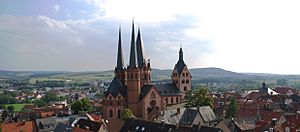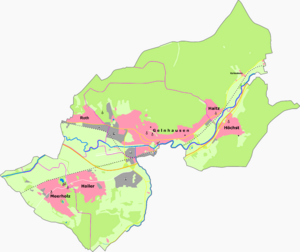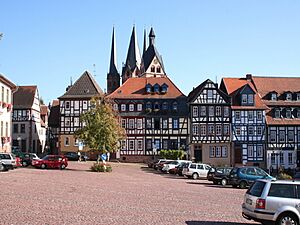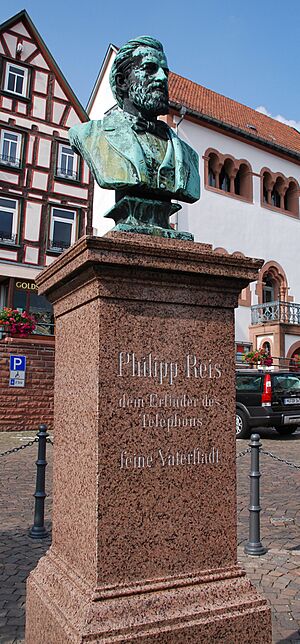Gelnhausen facts for kids
Quick facts for kids
Gelnhausen
|
||
|---|---|---|

View of Gelnhausen with the Marienkirche
|
||
|
||
| Country | Germany | |
| State | Hesse | |
| District | Main-Kinzig-Kreis | |
| Elevation | 180 - 312 m (−843.6 ft) | |
| Population
(2022-12-31)
|
||
| • Total | 23,679 | |
| Time zone | CET/CEST (UTC+1/+2) | |
| Postal codes |
63571
|
|
| Dialling codes | 06051 | |
| Vehicle registration | MKK, GN, SLÜ | |
Gelnhausen is a town in Hesse, Germany. It is the capital of the Main-Kinzig-Kreis district. The town is about 40 kilometers east of Frankfurt am Main. It sits between the Vogelsberg mountains and the Spessart range, right by the Kinzig River. Gelnhausen is one of eleven towns in its district and has about 22,000 people living there.
Contents
Geography
Where is Gelnhausen located?
For a few years, from 2007 to 2013, the exact center of the European Union was located near Gelnhausen. It was in a wheat field just outside the town!
Gelnhausen is also a stop on the famous German Fairy Tale Route. This is a special tourist road that connects many places linked to the Brothers Grimm fairy tales.
History of Gelnhausen
Gelnhausen was founded in 1170 by Emperor Frederick Barbarossa. This is why it is often called "Barbarossastadt" (Barbarossa City). The emperor chose this spot because it was where the important Via Regia trade route crossed other major roads. This route connected big cities like Frankfurt and Leipzig.
Frederick Barbarossa joined three villages together. He then built streets and a strong wall around them. At the same time, Gelnhausen was given special "town privileges." An impressive imperial palace, called a Kaiserpfalz, was also built on an island in the Kinzig River. The emperor also gave the town "trade privileges." One of these was the staple right. This meant that traveling merchants had to offer their goods for sale in Gelnhausen for three days.
Because of these special rights, Gelnhausen became a very busy and rich trading town. It even led a group of 16 towns in the Wetterau region. However, its success did not last forever. In 1326, Emperor Louis IV used the town as a guarantee for a loan to the counts of Hanau. The town was later bought back. In 1349, Emperor Charles IV gave Gelnhausen to Count Günther von Schwarzburg. This was part of a deal where Günther gave up his claim to be King of the Romans.
Over the centuries, the town changed hands many times. It was shared by different noble families. The Thirty Years' War (1618-1648) was a very difficult time for Gelnhausen. The town was attacked and looted many times. A famous writer, Hans Jakob Christoffel von Grimmelshausen, wrote about the destruction in his novel Simplicius Simplicissimus. The war made the town almost empty.
In 1803, Gelnhausen became part of the Landgraviate of Hesse-Kassel. Later, after a war in 1866, it became part of Prussia. By this time, Gelnhausen had recovered. It grew into an important center for Germany's rubber industry.
Gelnhausen during the Nazi era
During the Nazi era, the town's synagogue was closed. Jewish residents were forced to leave Gelnhausen in 1938.
From the 1930s, Gelnhausen was a military town for the German army, the Wehrmacht. After World War II, the United States Army used it as a base. The US Army closed its Coleman Kaserne base in Gelnhausen in 2007.
In 1996, Gelnhausen hosted the 36th Hessentag state festival. This is a big annual event in Hesse.
Arts and Culture
Main attractions to visit
Gelnhausen has many interesting historical places to see:
- Medieval Town Center: You can explore the old town with its historic buildings. These include the Romanisches Haus (Gelnhausen) (built around 1180) and the Gotisches Haus (Gelnhausen) (built in 1351/52).
- Kaiserpfalz Gelnhausen: This castle was built between 1160 and 1180. It is located on an island in the Kinzig River. To make sure it was stable, 12,000 logs were driven into the ground beneath it. Today, it is the best-preserved imperial palace from that time period.
- The Marienkirche (Gelnhausen): This church is the most famous landmark of Gelnhausen. It shows both Romanesque and Gothic architecture styles. The church was built from local red sandstone between 1170 and 1250. In 1543, Gelnhausen became Protestant, and the church became a Protestant church.
- The Catholic Church of Peterskirche (Gelnhausen): This church dates back to the early 13th century. After the Reformation, the building became the town's property. It fell into disrepair and was even used as a cigar factory for a while. In 1920, the Catholic community bought it back and restored it.
Governance
Town twinning with other cities
Gelnhausen has special partnerships with other towns around the world. This is called town twinning.
Infrastructure
How to get to Gelnhausen
Gelnhausen is located right next to the German autobahn A66. The Gelnhausen station is on the Kinzig Valley Railway. This is an important train line connecting Frankfurt and Fulda. Regional trains from Frankfurt to Fulda or Wächtersbach stop in Gelnhausen.
Notable People
Many interesting people have connections to Gelnhausen:
- Johann Philipp Reis (1834–1874): He was an inventor who created one of the first telephones.
- Oskar Fischinger (1900–1967): A famous film director.
- Tia and Tamera Mowry (born 1978): Actresses.
- Klaus Ploghaus (born 1956): An athlete who won a bronze medal in hammer throw at the 1984 Summer Olympics.
- Hans Jakob Christoffel von Grimmelshausen (c. 1622–1676): A writer who described the difficult times in Gelnhausen during the Thirty Years' War.
- Colin Powell: In 1959, before he became a famous general and politician, Colin Powell served as a lieutenant in Gelnhausen. A street was named after him.
See also
 In Spanish: Gelnhausen para niños
In Spanish: Gelnhausen para niños





